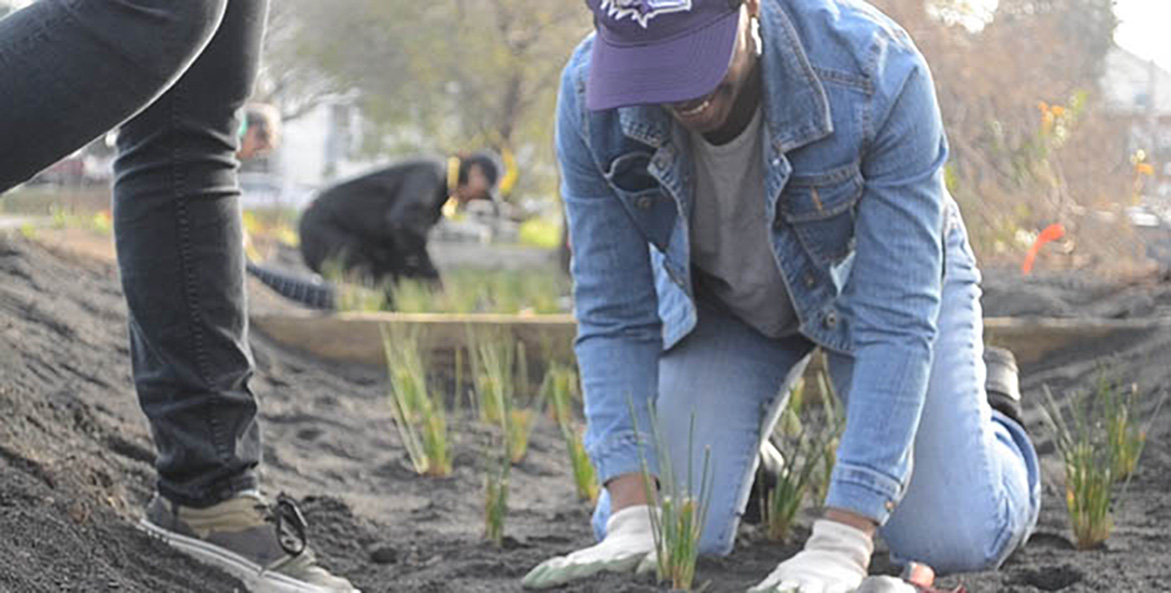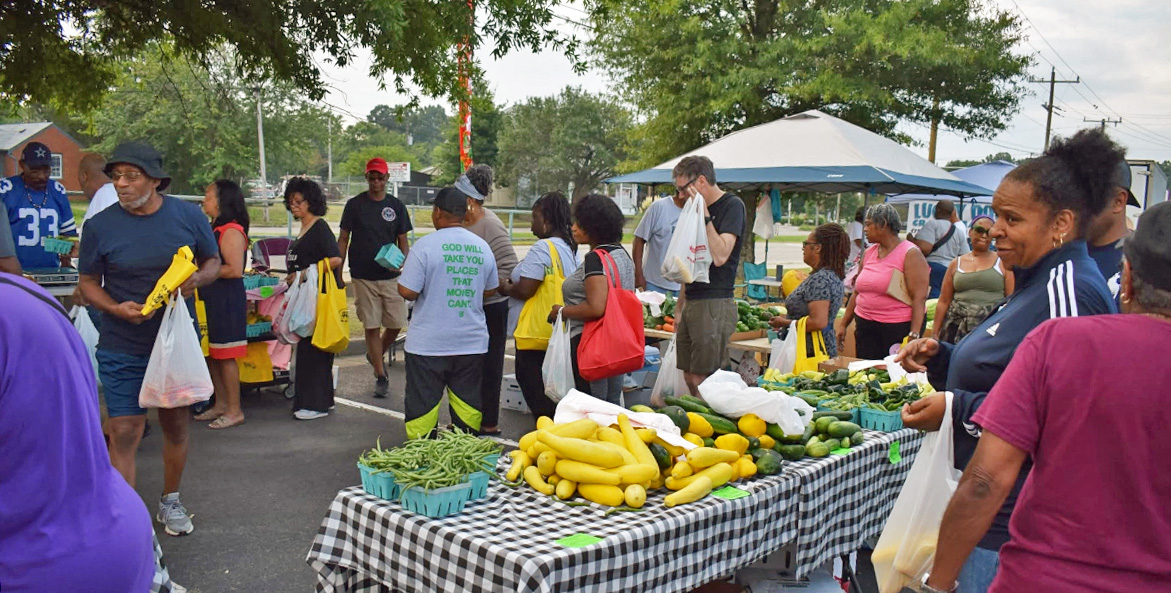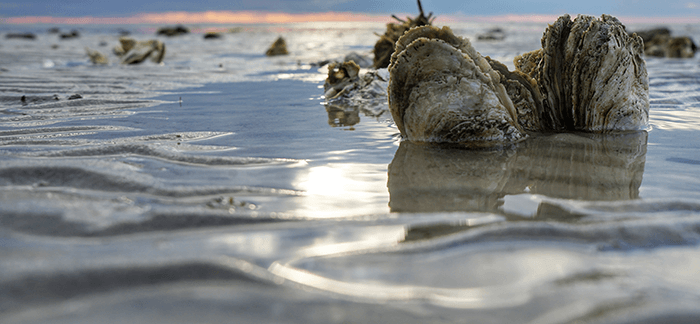A decade ago, Second Baptist Church’s South Richmond neighborhood had no reliable access to healthy food. There were no nice markets where parishioners could pick up fresh produce or grass-fed beef on their way home from Sunday services. What’s more, the rate of diet-related illnesses like diabetes and obesity was the highest in the city.
Ironically, church members worship in the building where the area’s last full-service supermarket, a Winn-Dixie, was located. The five-acre paved parking lot was nearly devoid of greenery. Rainwater running off the church’s massive roof and sprawling parking lot regularly dumped dirt, oil, debris and other pollutants into streams that feed the James River.
But today, Second Baptist Church is an oasis of healthy eating, exercise, and environmental stewardship. The transformation started in 2016, when the church partnered with the Chesapeake Bay Foundation, which had received a $150,000 grant from EPA’s Chesapeake Bay Program. Together, they planted an organic community garden to provide congregants with fresh, healthy food and a rain garden to keep stormwater runoff from the complex out of local streams.
And the story doesn’t end there. Since finishing the initial project in 2017, Second Baptist Church has gone on to create a charitable foundation, a thriving farmers’ market, a place where neighbors gather to get their steps in, and a commercial kitchen that serves healthy fare like sandwich wraps and salads after evening Bible study.
“I had envisioned certain things. But it exceeded my expectations,” said Pastor Ralph Hodge, who has led the historic church for 22 years. “We are now bringing food back to the very place that they used to have food.”
None of that would have happened without the grant funded by EPA’s Chesapeake Bay Program, Hodge said. The congregation had talked about reducing polluted stormwater runoff before. But replacing 18 parking spots with native plants and installing a 10,000-gallon cistern to capture rainwater from the roof was too costly for congregation that operates on a very tight margin.

Volunteers and Second Baptist Church congregation members work with CBF in 2016 to create an organic community garden, started with a grant from EPA's Chesapeake Bay Program.
Kenny Fletcher/CBF Staff
A grant to reduce flooding in Southside Richmond from EPA’s Chesapeake Bay Program made it happen.
In addition to providing these critical grants and support to make community projects like these happen, EPA’s Chesapeake Bay Program coordinates the vital federal-state Bay restoration partnership among six states, the District of Columbia, several federal agencies, local governments, universities, and community groups.
Bay Restoration Grants Benefit Local Communities
Roughly two-thirds of the Bay Program’s annual budget, currently $92 million, goes to grants that finance community projects like installing rain gardens and living shorelines, planting forested buffers, restoring wetlands, stream banks, and underwater grasses, fencing livestock out of streams, and many other activities essential to protecting the Bay and tributaries like the James River.
Since taking office in January, the Trump administration has frozen or canceled hundreds of millions of dollars in restoration grants from numerous federal agencies like EPA, including funds that put boots on the ground across the Bay region to carry out the day-to-day work of saving the Bay and its rivers and streams.
Rise up with us now.
Contact your members of Congress and urge them to do the right thing:
Protect environmental funding! Protect agency staffing!
Take Action
Hodge said that if CBF’s grant had been frozen or canceled in 2016, the spark that started the community’s healthy living movement would never have been lit.
“If we didn’t start off with that big project with CBF, we probably just wouldn’t have—See, a movement starts with sparks.” In this case, the spark was the Bay Program grant that funded the original stormwater and community garden project in 2016.
“Then that started us thinking about what else we could do,” Hodge said about starting the farmers’ market. “And that started us thinking about what else we could do. So, you know, the spark of that—if that didn’t happen,” he said, none of the initiatives that grew out of the farmers market would have happened either.
Market Day
From May through October, Broad Rock Farmers Market is “a sight to behold,” Hodge said. There’s plenty to hear, too. A Spanish-language radio station might be broadcasting live. Music is probably playing. Or maybe there’s a DJ.
I think what we’ve done is created something that is a beautiful picture of how God wants us to manage our bodies, manage creation, and manage our society.
Hundreds of people gather on the first and third Saturday of the month to shop for fresh, locally produced vegetables, fruit, grass-fed beef and burgers, seafood, and natural products like fresh juices and honey from Second Baptist’s own hives. Shoppers who get Supplemental Nutrition Assistance Program (SNAP) benefits, as many in the community do, get their benefits doubled up to a certain amount.
The vendors are all black and brown, Hodge said. Hodge comes from a farming background. His grandfather, a North Carolina tobacco farmer, experienced racial discrimination firsthand.
“If you go to other farmers markets, you don’t have a lot of black and brown farmers. They’re oftentimes squeezed out. So, we wanted to correct some historical disparities with regards to farmers’ access to platforms” for selling their products, Hodge explained.
The market even buys back what isn’t sold. “Farmers don’t lose any money with us. It’s a win-win for everybody,” Hodge said. The church takes leftover food to a local shelter or makes it available for church-goers Sunday morning. Signs and information are in Spanish as well as English “so no feels left out. Everyone feels comfortable,” Hodge said.
‘Paying’ People to Walk with Good Food
While some folks shop, others get moving. Four laps around the six-acre property—equivalent to a mile and a half, Hodge figures—earns walkers a $20 credit at the market. Local Girl Scouts set up a walking trail and water stations, record how many laps walkers complete, and cheer them on as they go.
Hodge said people are so eager to start pounding the pavement that they’re lined up and ready to go before the market opens at 8 a.m. “We’re ‘paying’ people to walk and we’re paying them with good food. And they’re out there having a good time,” Hodge said.
Some even give back the credits they earned for others to use. They’re only there for the exercise. The walking has been so popular that Second Baptist added “wellness walks” and line dancing on Wednesdays to meet the demand. Hodge said members of the Latino community come out and walk with their kids during the week too.
“They love it. And everyone is out. Even people who shouldn’t be walking are out there, you know, walking with walkers. And rollators,” Hodge said. “They’re not moving slow. I mean, there’ll be people out [there in] their 80s like it’s nothing.”
The Power of a Spark
Pastor Hodge is proud of how Broad Rock Farmers Market is transforming his congregation and their community.
“It’s promoting health eating. It’s promoting exercise. It’s promoting community. It’s promoting entrepreneurship. For pennies, for the most part. And farmers are encouraged to farm. They’re encouraged to continue that great work of growing food in a way that is health, a way that is beneficial,” he said.
“I think what we’ve done is created something that is a beautiful picture of how God wants us to manage our bodies, manage creation, and manage our society. I could never envision it would come together.”
But it did, thanks to a grant that sparked a movement.

Washington, D.C. Communications & Media Relations Manager, CBF
[email protected]
202-793-4485



